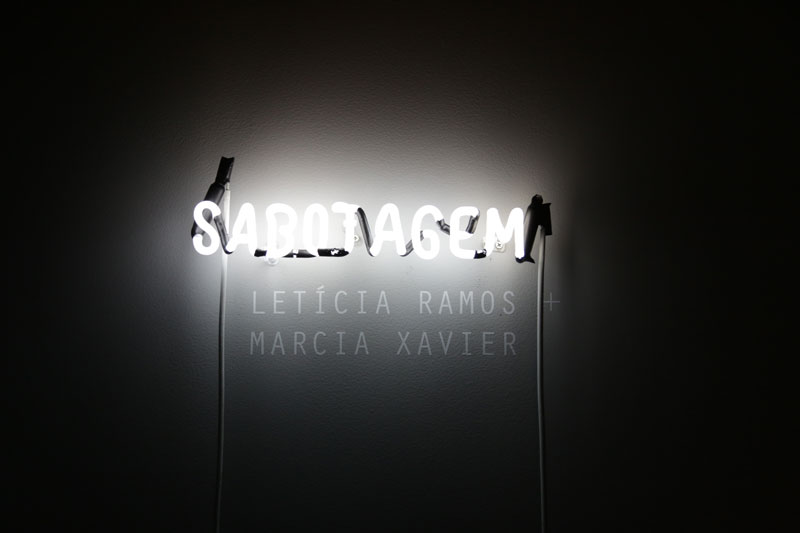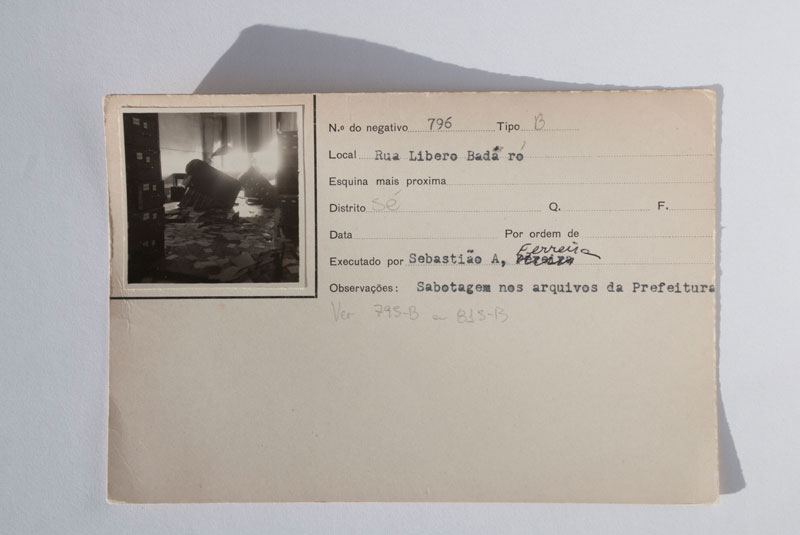







Letícia Ramos + Marcia Xavier
Casa da Imagem - São Paulo, Brazil, 2014
September 20th to October 26th 2014
Márcia Xavier and
Letícia Ramos created a set of works from a selection of enigmatic and
“anonymous” images from the photography collection of the Museu da Cidade de
São Paulo (Museum of City of São Paulo). The images reveal an act of vandalism
in the municipal archives of São Paulo during the demonstrations of August
1947.
By crossing actual data with several
fictional hypotheses about what happened, it addressed the physical and optical
issues of building a scene. Based on criminal identification photography and
movement study, a series of strobe photographs was presented, picturing
simulations of falling found objects as protagonists in historical photographs.
The works, in their different formats, provoke in the viewer a certain
vagueness about the temporality of images.
SABOTAGE
When Letícia Ramos e Márcia Xavier chose, from
the vast collection of Casa da Imagem, the photographs of
destruction of an archive room as a starting point for their
conjoint exposition in that institution, they didn’t know that
those photographs were about.
Sabotage? Vandalism? Destruction of evidence?
The black and white photographs carried marks of
the time and circumstances in which they were taken. More
than a journalistic approach, they looked like police records
of the incident. The large metallic filing cabinets full of old
paper documents suggested a scenery from the middle of
the last century.
They could locate, in one of the documents spread
across the floor of the destroyed place, a year: 1944. In the
very files of Casa da Imagem they found that the incident
happened at São Paulo’s city Hall’s head office.
By research in newspapers in that time (from 1944
to 1950), they found, in O Estado de São Paulo of August 2,
1947, the exact reference in the headline: “Fires, stonings,
forays, shootings on the streets and squares of São Paulo”,
along with: “The City Hall’s head office on Líbero Badaró
Street was stoned and then assaulted”.
Then, they discovered it was the aftermath of the
protests against the rise of mass transit’s fares at that time.
The astounding coincidence with the events that took place
in São Paulo in the first semester of 2014 was one more link
in a net of documentary investigation and artistic instigation,
which motivated the artists.
From this puzzle of facts and photographs, Márcia
and Letícia started to conceive this environment-installation,
where six overhead retroprojectors; a backlight with the light
from one of the windows; a peephole; prerecorded sounds,
and microphones that capture in real-time the steps of the
ones that enter; a film produced and projected in 16 mm
simulating facts that can be only intuited; and a sequence
of stroboscopic pictures of a filing cabinet falling in space
compose the dense and tense atmosphere of sabotage.
The motor of this creation isn’t the chronicle, the
fidelity to the facts, or the social criticism of that context,
but the transmutation of vestiges and clues into a sensitive
experience, in present time.
There is no clear narrative, but an appropriation of
a universe of references in order to create an environment
from which hatch sensations of dazzle and fear, beauty and
menace, vertigo and violence, order and disorder. Traces,
signs, nods of hidden facts. Like a film noir with no plot.
Different from Hélio Oiticica’s “seja marginal/seja
herói” [“be an outlaw/be a hero”], this appropriation of the
criminal universe (or the breaking of social norms) doesn’t
come impregnated with an ideological bias. It seems only an
inspiration.
The relation is made more by a metonymic
association, in which the photographs not only become
part of the installation (changed by projections, distortions,
and optical devices) but also serve as an impulse to the
constitution of its atmosphere. Spots of chaos on the tissue of
social order, motivating the changing of our preestablished
cognitive structures.
Instead of a message, a mood.
Instead of a narrative,
a sensorial experience – which wraps the visitor in sound,
light, image, touch. Sabotage of the senses.
The fact that this environment is set precisely in an
institution which purpose is to keep an organized collection
of old images (materialized memory) establishes a paradox
that subverts our perception of real.
This subversion evokes something sublime when it
throws us in the vertigo of an atavistic disorder, set in the
orderly space where its spark was archived.
Arnaldo Antunes
2014
